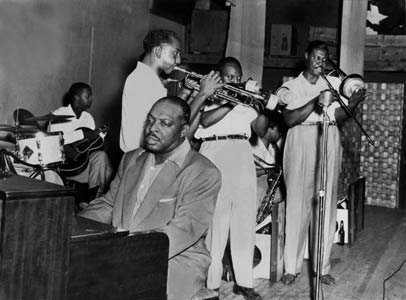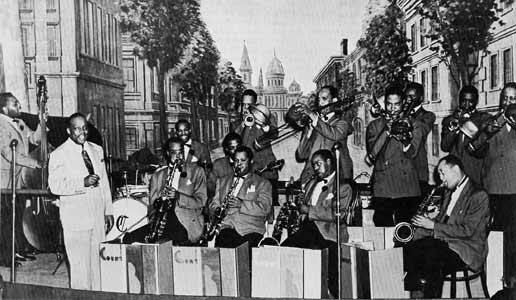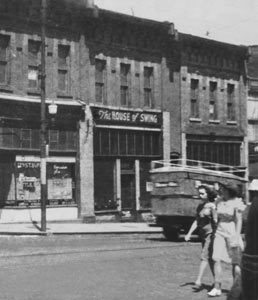In his book The History of Jazz Ted Gioia writes about the innovative and widely influential sound of the Count Basie rhythm section. "No one filled [the] new role—that of the "comping" pianist—better than Count Basie. As such, he remains the best remembered of the Kansas City pioneers. In this symbiotic process Basie, Page, and Jones collectively reengineered the nature of time and space in the context of jazz…”
The importance of the Count Basie Orchestra in the development of jazz cannot be overstated. In addition to the landmark contribution of the Basie rhythm section, his big band played with the freewheeling, loose swing of a much smaller jazz combo at an informal jam session. And Basie gave plenty of solo space to outstanding improvisers including Lester Young, Herschel Evans, 'Hot Lips' Page and 'Sweets' Edison.

Benny Moten's Victor Recording Orchestra, Count Basie 2nd from right, 1930. Photo courtesy Rutgers University, Institute of Jazz Studies
Although he was born and raised in Red Bank, New Jersey, Count Basie played a key role in the emergence of the Kansas City style of jazz. Its roots were in the blues and the informal jam session tradition. You might say getting stranded in Kansas City was the best thing that ever happened to Count Basie. It was 1927, and the vaudeville show he'd been traveling with, Gonzelle White's Jazz Jamboree, disbanded there, and Basie soon fell in with local musicians, eventually joining Walter Page’s Blue Devils.
In his autobiography Good Morning Blues, Basie described the first time he heard the Blue Devils performing on the back of a truck. "I just stood there listening and looking, because I had never heard anything like that band in my life. It was such a team spirit among those guys, and it came out in the music… Everything about them really got to me, and as things worked out, hearing them that day was probably the most important turning point in my musical career."
Later, Basie and a nucleus of Blue Devils players joined the Bennie Moten Orchestra. Moten died unexpectedly and Basie took over leadership of the band, which by then called themselves the Barons of Rhythm.
Radio broadcasts of the Basie-led band from the Reno Club in Kansas City in 1935 attracted the attention of Eastern promoters. Tuning in to a late night broadcast on his much-used and now legendary car radio, John Hammond ‘discovered’ the Basie band and secured a Decca recording contract and appearances in New York City.
In January 1938 the Count Basie Orchestra hit it big in New York with a long-running gig at the Savoy Ballroom in Harlem, the "Home of Happy Feet." Benny Goodman’s rival for the 'King of Swing' title had arrived and was staking out his territory.
After a period of great popularity and success during the 1930s and '40s, big swing bands fell on hard economic times after the advent of television in the 1950s. Many disbanded. Basie reinvented the form with a new band concept that featured flawless execution and elegant, swinging arrangements and compositions that came to be known as his 'New Testament' sound. Basie's 'New Testament' style quickly became a new model for big bands and is still to this day widely admired among jazz musicians, educators and listeners.

The Count Basie Orchestra during a 1953 rehearsal featuring, l-r: Freddie Green, guitar; Basie; Joe Newman and Reunauld Jones, trumpets; and Henry Coker, trombone. Photo courtesy Rutgers University, Institute of Jazz Studies.
This week on Riverwalk Jazz, The Jim Cullum Jazz Band celebrates the Basie Beat with encore presentations by Basie Band veterans, trumpeters 'Sweets' Edison and Clark Terry, and vocalist Joe Williams, who joined Jim and the Band on stage at The Landing in San Antonio. Also on the show, rare archival clips from Basie sideman, tenor saxophonist Frank Foster and Count Basie himself.
Photo credit for Home Page: Basie (2nd from left) with the Sunny Kings of Syncopation, 1922. Courtesy Rutgers Univ.
Text based on Riverwalk Jazz script by Margaret Moos Pick ©2009



